Bright Spiral Galaxy M81 : One Of The Brightest Galaxies In Planet Earths Sky Is Similar In Size To Our

Bright Spiral Galaxy M81 : One of the brightest galaxies in planet Earths sky is similar in size to our Milky Way Galaxy: big, beautiful M81. This grand spiral galaxy can be found toward the northern constellation of the Great Bear . This superbly detailed view reveals M81s bright yellow nucleus, blue spiral arms, and sweeping cosmic dust lanes with a scale comparable to the Milky Way. Hinting at a disorderly past, a remarkable dust lane actually runs straight through the disk, to the left of the galactic center, contrary to M81s other prominent spiral features. The errant dust lane may be the lingering result of a close encounter between M81 and its smaller companion galaxy, M82. Scrutiny of variable stars in M81 has yielded one of the best determined distances for an external galaxy 11.8 million light-years. via NASA
js
More Posts from Fillthevoid-with-space and Others
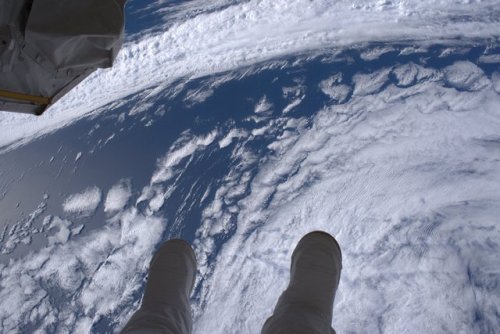
It’s a long ways down. This is a view from the vantage point of astronaut Shane Kimbrough during his spacewalk last Friday outside the International Space Station. Shane posted this photo and wrote, “ View of our spectacular planet (and my boots) during the #spacewalk yesterday with @Thom_astro.” During the spacewalk with Kimbrough and Thomas Pesquet of ESA, which lasted just over six-and-a-half hours, the two astronauts successfully disconnected cables and electrical connections to prepare for its robotic move Sunday, March 26.
Two astronauts will venture outside the space station again this Thursday, March 30 for the second of three spacewalks. Kimbrough and Flight Engineer Peggy Whitson will begin spacewalk preparation live on NASA Television starting at 6:30 a.m. EST, with activities beginning around 8 a.m. Watch live online here.
Make sure to follow us on Tumblr for your regular dose of space: http://nasa.tumblr.com


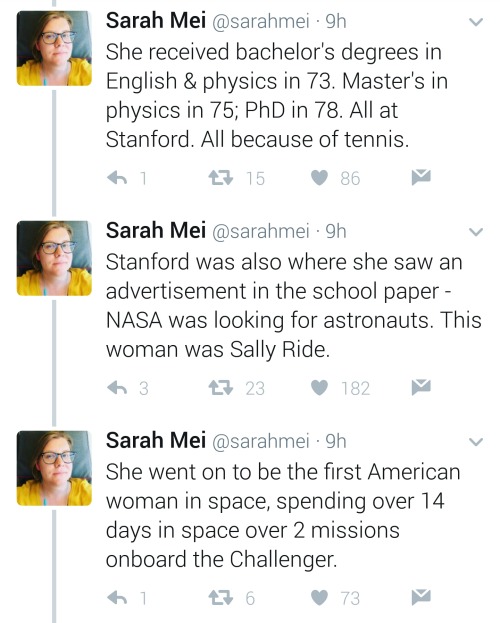
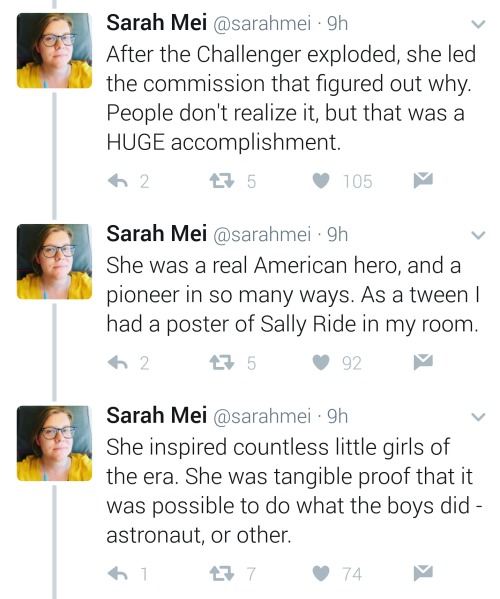
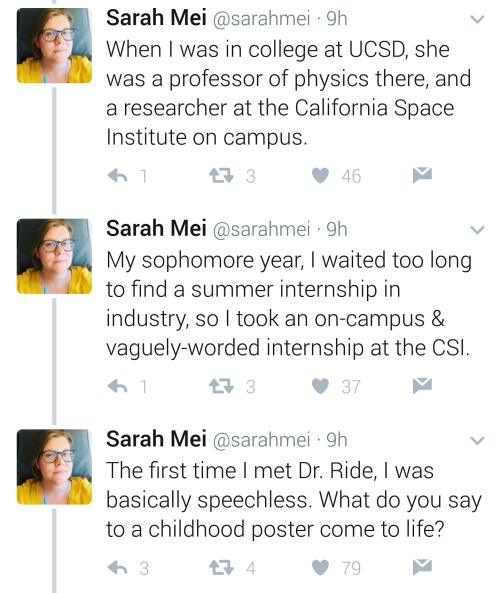
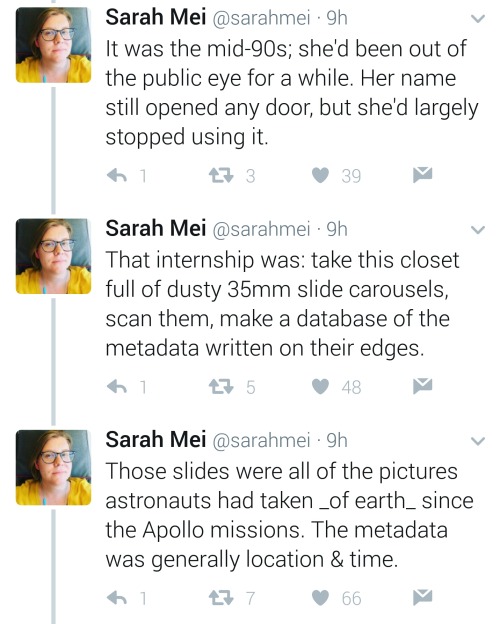
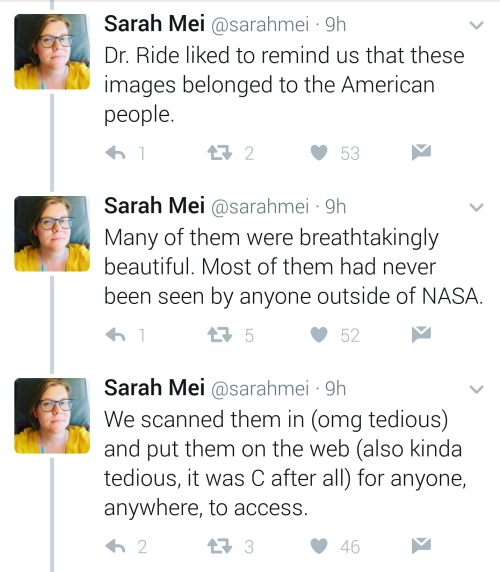
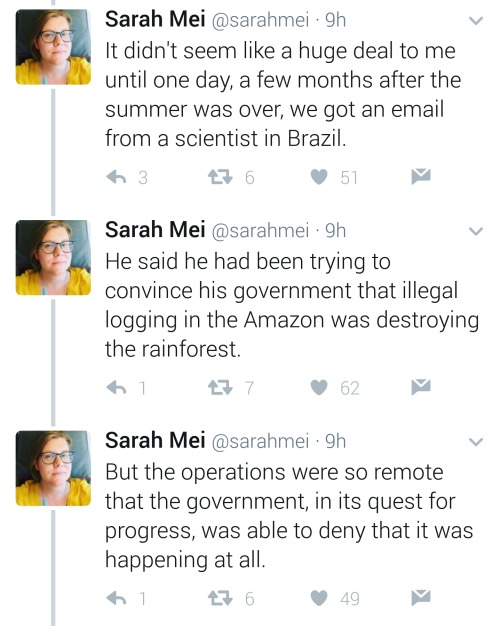
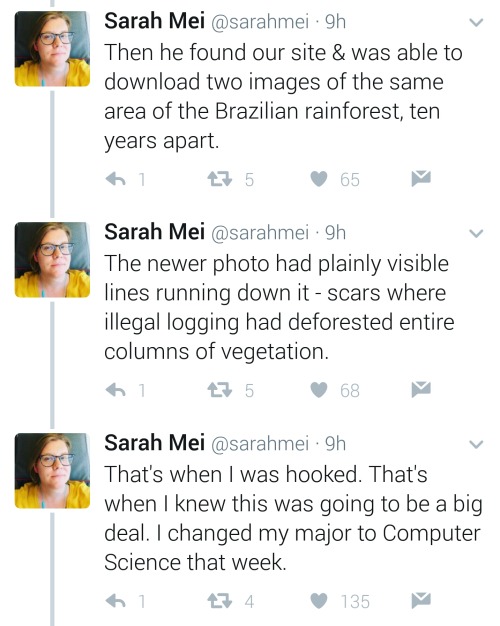
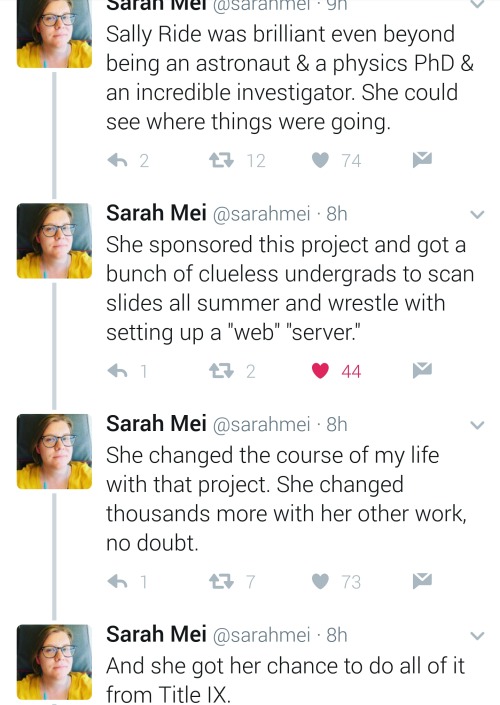
Equal opportunity benefits can be far-reaching
https://twitter.com/sarahmei/status/818682610712866817

UGC 12591: The Fastest Rotating Galaxy Known : Why does this galaxy spin so fast? To start, even identifying which type of galaxy UGC 12591 is difficult – it has dark dust lanes like a spiral galaxy but a large diffuse bulge of stars like a lenticular. Surprisingly observations show that UGC 12591 spins at about 480 km/sec, almost twice as fast as our Milky Way, and the fastest rotation rate yet measured. The mass needed to hold together a galaxy spinning this fast is several times the mass of our Milky Way Galaxy. Progenitor scenarios for UGC 12591 include slow growth by accreting ambient matter, or rapid growth through a recent galaxy collision or collisions – future observations may tell. The light we see today from UGC 12591 left about 400 million years ago, when trees were first developing on Earth. via NASA
js

YO THAT SHIT BALLER AS FUCK HOLY SHIT
NASA's Swift Mission Maps a Star's 'Death Spiral' into a Black Hole
NASA - Swift Mission patch. March 20, 2017 Some 290 million years ago, a star much like the sun wandered too close to the central black hole of its galaxy. Intense tides tore the star apart, which produced an eruption of optical, ultraviolet and X-ray light that first reached Earth in 2014. Now, a team of scientists using observations from NASA’s Swift satellite have mapped out how and where these different wavelengths were produced in the event, named ASASSN-14li, as the shattered star’s debris circled the black hole. “We discovered brightness changes in X-rays that occurred about a month after similar changes were observed in visible and UV light,” said Dheeraj Pasham, an astrophysicist at the Massachusetts Institute of Technology (MIT) in Cambridge, Massachusetts, and the lead researcher of the study. “We think this means the optical and UV emission arose far from the black hole, where elliptical streams of orbiting matter crashed into each other.”
Swift Charts a Star’s ‘Death Spiral’ into Black Hole
Video above: This animation illustrates how debris from a tidally disrupted star collides with itself, creating shock waves that emit ultraviolet and optical light far from the black hole. According to Swift observations of ASASSN-14li, these clumps took about a month to fall back to the black hole, where they produced changes in the X-ray emission that correlated with the earlier UV and optical changes. Video Credits: NASA’s Goddard Space Flight Center. Astronomers think ASASSN-14li was produced when a sun-like star wandered too close to a 3-million-solar-mass black hole similar to the one at the center of our own galaxy. For comparison, the event horizon of a black hole like this is about 13 times bigger than the sun, and the accretion disk formed by the disrupted star could extend to more than twice Earth’s distance from the sun. When a star passes too close to a black hole with 10,000 or more times the sun’s mass, tidal forces outstrip the star’s own gravity, converting the star into a stream of debris. Astronomers call this a tidal disruption event. Matter falling toward a black hole collects into a spinning accretion disk, where it becomes compressed and heated before eventually spilling over the black hole’s event horizon, the point beyond which nothing can escape and astronomers cannot observe. Tidal disruption flares carry important information about how this debris initially settles into an accretion disk. Astronomers know the X-ray emission in these flares arises very close to the black hole. But the location of optical and UV light was unclear, even puzzling. In some of the best-studied events, this emission seems to be located much farther than where the black hole’s tides could shatter the star. Additionally, the gas emitting the light seemed to remain at steady temperatures for much longer than expected. ASASSN-14li was discovered Nov. 22, 2014, in images obtained by the All Sky Automated Survey for SuperNovae (ASASSN), which includes robotic telescopes in Hawaii and Chile. Follow-up observations with Swift’s X-ray and Ultraviolet/Optical telescopes began eight days later and continued every few days for the next nine months. The researchers supplemented later Swift observations with optical data from the Las Cumbres Observatory headquartered in Goleta, California.
Image above: This artist’s rendering shows the tidal disruption event named ASASSN-14li, where a star wandering too close to a 3-million-solar-mass black hole was torn apart. The debris gathered into an accretion disk around the black hole. New data from NASA’s Swift satellite show that the initial formation of the disk was shaped by interactions among incoming and outgoing streams of tidal debris. Image Credit: NASA’s Goddard Space Flight Center. In a paper describing the results published March 15 in The Astrophysical Journal Letters, Pasham, Cenko and their colleagues show how interactions among the infalling debris could create the observed optical and UV emission. Tidal debris initially falls toward the black hole but overshoots, arcing back out along elliptical orbits and eventually colliding with the incoming stream. “Returning clumps of debris strike the incoming stream, which results in shock waves that emit visible and ultraviolet light,” said Goddard’s Bradley Cenko, the acting Swift principal investigator and a member of the science team. “As these clumps fall down to the black hole, they also modulate the X-ray emission there.”
Swift spacecraft. Image Credit: NASA
Future observations of other tidal disruption events will be needed to further clarify the origin of optical and ultraviolet light. Goddard manages the Swift mission in collaboration with Pennsylvania State University in University Park, the Los Alamos National Laboratory in New Mexico and Orbital Sciences Corp. in Dulles, Virginia. Other partners include the University of Leicester and Mullard Space Science Laboratory in the United Kingdom, Brera Observatory and the Italian Space Agency in Italy, with additional collaborators in Germany and Japan. Related: Scientists Identify a Black Hole Choking on Stardust (MIT): http://news.mit.edu/2017/black-hole-choking-stardust-0315 ASASSN-14li: Destroyed Star Rains onto Black Hole, Winds Blow it Back: http://chandra.harvard.edu/photo/2015/tidal/ 'Cry’ of a Shredded Star Heralds a New Era for Testing Relativity: https://www.nasa.gov/mission_pages/swift/bursts/shredded-star.html Researchers Detail How a Distant Black Hole Devoured a Star: https://www.nasa.gov/mission_pages/swift/bursts/devoured-star.html All Sky Automated Survey for SuperNovae (ASASSN): http://www.astronomy.ohio-state.edu/~assassin/index.shtml Las Cumbres Observatory: https://lco.global/ NASA’s Swift: http://www.nasa.gov/mission_pages/swift/main/index.html Images (mentioned), Video (mentioned), Text, Credits: NASA’s Goddard Space Flight Center, by Francis Reddy/Karl Hille. Greetings, Orbiter.ch Full article

The last episode I posted went up on a very special birthday that I failed to acknowledge or, well, realize was even happening until I saw it on the Google homepage. So, to rectify this oversight, I’m talking about the history of cosmological photography and how we reached the high point of the Hubble Space Telescope, which turned 27 this past April 24th!
Below the cut is some elaboration on the episode itself, including my sources, music credits, a glossary, and a transcript (not an exact record of this episode, but it’s the loose, fairly conversational script I was working with). I mention a couple of books and authors in this episode so if you want to see that written down, those are there too (one of the authors is Chinese and listen, Chinese is at least as hard for me to pronounce as French. I did try though). I’m also on Twitter at @HDandtheVoid, though I keep forgetting I have it. Talk to me on there and maybe I won’t forget!
Let me know what you think of this episode, let me know what you think I should research next*, tell me a fun space fact… anything’s helpful at this point!
*(Move fast if you feel strongly about what I research next, though, cuz I have to get it done by May 22nd! My thoughts were henges because I didn’t get to them this week, probes and satellites, the planets, spectroscopy, or maybe black holes? Please hit me up by May 11th so I can start working on it!)
Glossary:
catadioptric/Cassegrain telescope - use lenses and mirrors in combination.
focal length - the distance between the lens and the image sensor of a camera when the subject of the photo is in focus. According to the Nikon website this is usually measured in millimeters, but I’ll take a wild guess and say it’s probably easier to measure it in feet on the Hubble Telescope because that thing is school bus-sized.
Lagrange points - five points where three bodies can orbit each other, yet stay in the same position relative to each other in a stable configuration. L1-L3 are in line with each other, while L4 and L5 are at the points of equilateral triangles in the configuration. See an example specific to the James Webb Telescope in the link.
objective lens - the optical element that gathers light from the object being observed and focuses the light rays to produce an image at the focal point.
reflection telescope - reflects light rays off the concave surface of a parabolic mirror to get an image of a distant object. Higher contrast image, worse color quality.
refraction telescope - uses convex lenses to focus a far-off, dim image. Good color quality, poor contrast.
satellites - objects that move around a larger object. Can be man-made or natural. Geostationary satellites orbit west to east over the equator, moving in the same direction and at the same rate as Earth. Polar-orbiting satellites orbit north to south, which allows them to scan the Earth along longitude lines.
Wilkinson Microwave Anisotropy Probe—a spacecraft operating from 2001 to 2010 which measured temperature differences in the cosmic microwave background radiation leftover from the Big Bang. It orbited at L2, just like the James Webb Telescope will!
Script/Transcript (I do tend to embellish in the moment of recording so it’s not exact, but all the facts are there and I can’t know a fact and not talk about it so trust me, all you’re missing is probably another swear word or two)
Sources:
Facts about telescopes via the Naperville Astronomical Association
More facts about telescopes via Western Washington University
Earth’s atmosphere definition via the Encyclopedia Britannica Online
Correcting for atmospheric interference in astronomical imaging
Info on satellites for K-4th grade via NASA
Info on satellites for 5th-8th grade via NASA
What focal length means in photography via Nikon (the camera brand)
Hermann Oberth’s museum website
The history of NASA’s Orbiting Astronomical Observatories, which an older British gentleman seems to like enough to run a website about it
The history of OAO-3 aka Copernicus via NASA
Info on the Hubble Space Telescope for K-4th grade via NASA
Hubble-T’s 25th anniversary website, which I highly recommend. The timeline is a dream come true in terms of organization and brevity. It was last updated in December 2014, though, since that was when the Hubble was 25, so not a lot of new info there.
What the Hubble Space Telescope looks like, all its parts, and some of its history
What Hubble-T is looking at right now and why
The history of maintenance missions to the Hubble-T
Hubble: The Beginning, a 4-minute documentary video with a couple interviews, including Nancy Roman!
Hubble’s YouTube channel!!!!!!!!
Spitzer Space Telescope website
James Webb Space Telescope website
Hirshfeld, Alan. Starlight Detectives. Bellevue Library Press: NY, 2014.
Liu, Cixin. The Three-Body Problem. Trans. Ken Liu. Tor Books: NY, 2016.
Intro Music: ‘Better Times Will Come’ by No Luck Club off their album Prosperity
Filler Music: ‘Supermassive Black Hole’ by Muse off their album Black Holes and Revelations
Outro Music: ‘Fields of Russia’ by Mutefish off their album On Draught

February is Black History Month, and it’s been the perfect excuse to research all of the African-American people who have contributed to space research and exploration! I talk about seven astronomers and nine astronauts who have delved into outer space because it was just so dang amazing, nothing could stop them from learning about it; astrophiles, if you will. Space-lovers.
Below the cut, I have the transcript, sources, music credits, and timeline of people I talked about! Maybe you have something you want to hear me talk about that’s related to space. I’m kind of set for topics for the next few months but I’ll take suggestions here or you can tweet at me on Twitter at @HDandtheVoid, or you can ask me to my face if you know me. Please subscribe on iTunes, rate my humble podcast and maybe review it, and tell friends if you think they’d like to hear it!
(My thoughts on the next episode are the SOFIA observatory, Chuck Yaeger, the transit of Venus, or quasars and blasars. The next episode will go up March 19th, unfortunately; I have a work retreat the day I’d usually post and I don’t trust the wifi out there. See you then!)
Script/Transcript
Timeline
Benjamin Banneker, American (1731-1806)
Dorothy Vaughan, American (1910-2008)
Katherine Johnson, American (1918- )
Mary Jackson, American (1921-2005)
Ed Dwight, American (1933- )
Robert Henry Lawrence, American (1935-1967)
Doctor Arthur Bertram Cuthbert Walker II, American (1936-2001)
Frederick Gregory, American (1941- )
Guion "Guy" Bluford, American (1942- )
Doctor Ronald E. McNair, American (1950-1986)
Ilan Ramon, Israeli, American (1954-2003)
Doctor Bernard Harris, Jr., American (1956- )
Doctor Mae Jemison, American (1956- )
Neil DeGrasse Tyson, American (1958- )
Michael P. Anderson, American (1959-2003)
Leland Melvin, American (1964- )
Doctor Beth A. Brown, American (1969-2008)
Sources
African Americans in Astronomy and Space via ThoughtCo (Mar 2017)
Benjamin Banneker via Encyclopedia Britannica
Benjamin Banneker via PBS
Benjamin Banneker via America’s Library
Benjamin Banneker via Brookhaven National Laboratory
Hidden Figures (2016)
Katherine Johnson via NASA
Mary Jackson via NASA
Dorothy Vaughan via NASA
Doctor Arthur Bertram Cuthbert Walker II via Encyclopedia Britannica
Doctor Arthur Bertram Cuthbert Walker II obituary via the American Astronomical Society
Ed Dwight via The History Makers
Robert Henry Lawrence via Black Past
Robert Henry Lawrence via PBS
Robert Henry Lawrence via Hill Air Force Base
Guion "Guy" Bluford via Space.com (Feb 2017)
Guion Bluford: “I mean, I laughed and giggled all the way up. It was such a fun ride.”
Guion "Guy" Bluford via NASA
Guion "Guy" Bluford via Encyclopedia Britannica
Doctor Ronald E. McNair via NASA
Doctor Ronald E. McNair via Black Past
Doctor Ronald E. McNair via New Jersey Institute of Technology
Frederick “Fred” Gregory via NASA
Frederick “Fred” Gregory via Black Past
The Harris Foundation website
“empower individuals, in particular minorities and others who are economically and/or socially disadvantaged, to recognize their potential and pursue their dreams.”
Doctor Mae Jemison via NASA
Doctor Mae Jemison via NASA
Doctor Mae Jemison via the U.S. National Library of Medicine
Mae Jemison: “I followed the Gemini, the Mercury, and the Apollo programs, I had books about them and I always assumed I would go into space. Not necessarily as an astronaut; I thought because we were on the moon when I was 11 or 12 years old, that we would be going to Mars—I'd be going to work on Mars as a scientist. And that's despite the fact that there were no women, and it was all white males—and in fact, I thought that was one of the dumbest things in the world, because I used to always worry, believe it or not as a little girl, I was like: What would aliens think of humans? You know, these are the only humans?”
Michael P. Anderson via NASA
Michael P. Anderson via Black Past
Ilan Ramon via NASA
Leland Melvin via Space.com (Nov 2017)
Leland Melvin as Makers Men via Space.com (May 2017)
Leland Melvin via NASA
Leland Melvin via Pioneer Works
Doctor Beth A. Brown via the American Physical Society
Doctor Beth A. Brown via the American Astronomical Society
Doctor Beth A. Brown via NASA
Neil DeGrasse Tyson via Hayden Planetarium
Neil DeGrasse Tyson via the New Yorker
StarTalk Radio via Apple Podcasts
Intro Music: ‘Better Times Will Come’ by No Luck Club off their album Prosperity
Filler Music: ‘Dorothy Dandridge Eyes (feat. Esperanza Spalding)’ by Janelle Monáe off her album The Electric Lady.
Outro Music: ‘Fields of Russia’ by Mutefish off their album On Draught
It’s international dark sky week! Please enjoy this great Bortle scale.
skyglowproject What sky do you live under? Learn more at SKYGLOWPROJECT.COM
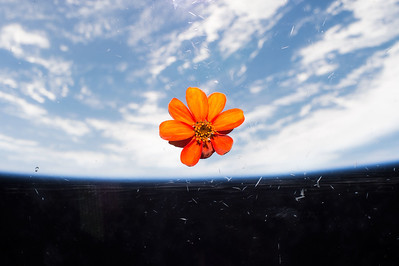
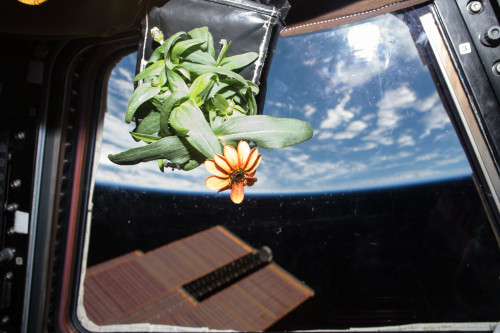

Take a moment, look outside your window. 🌷🌼
Today is the #FirstDayOfSpring in the Northern Hemisphere, also known as the vernal equinox.
#DYK Earth’s tilted axis causes the season? Throughout the year, different parts of Earth receive the Sun’s most direct rays. So, when the North Pole tilts toward the Sun, it’s summer in the Northern Hemisphere. And when the South Pole tilts toward the Sun, it’s winter in the Northern Hemisphere.
These images are of Zinnias. They are part of the flowering crop experiment that began aboard the International Space Station on Nov. 16, 2015, when NASA astronaut Kjell Lindgren activated the Veggie system and its rooting “pillows” containing zinnia seeds.
Make sure to follow us on Tumblr for your regular dose of space: http://nasa.tumblr.com.
-
 meditationrelaxationmusic reblogged this · 4 years ago
meditationrelaxationmusic reblogged this · 4 years ago -
 youfoundmy liked this · 5 years ago
youfoundmy liked this · 5 years ago -
 limedog liked this · 5 years ago
limedog liked this · 5 years ago -
 seamless-world liked this · 5 years ago
seamless-world liked this · 5 years ago -
 mrprocrastin8 liked this · 5 years ago
mrprocrastin8 liked this · 5 years ago -
 mammagoodlove liked this · 5 years ago
mammagoodlove liked this · 5 years ago -
 matt-in-the-multiverse reblogged this · 5 years ago
matt-in-the-multiverse reblogged this · 5 years ago -
 shawnarichauthor liked this · 5 years ago
shawnarichauthor liked this · 5 years ago -
 mr80james liked this · 5 years ago
mr80james liked this · 5 years ago -
 lenw reblogged this · 5 years ago
lenw reblogged this · 5 years ago -
 jeebssred liked this · 5 years ago
jeebssred liked this · 5 years ago -
 astelbanana liked this · 5 years ago
astelbanana liked this · 5 years ago -
 therealsirsticker liked this · 5 years ago
therealsirsticker liked this · 5 years ago -
 blackjulip liked this · 5 years ago
blackjulip liked this · 5 years ago -
 otterwerx liked this · 5 years ago
otterwerx liked this · 5 years ago -
 nib333 reblogged this · 5 years ago
nib333 reblogged this · 5 years ago -
 jacquelinesantiago liked this · 5 years ago
jacquelinesantiago liked this · 5 years ago -
 nib333 reblogged this · 5 years ago
nib333 reblogged this · 5 years ago -
 nib333 liked this · 5 years ago
nib333 liked this · 5 years ago -
 firebirdtransam68 liked this · 5 years ago
firebirdtransam68 liked this · 5 years ago -
 realastateadmierer reblogged this · 5 years ago
realastateadmierer reblogged this · 5 years ago -
 fallensusu liked this · 5 years ago
fallensusu liked this · 5 years ago -
 ambiguoud liked this · 5 years ago
ambiguoud liked this · 5 years ago -
 consecutivenormalpunches22 reblogged this · 5 years ago
consecutivenormalpunches22 reblogged this · 5 years ago -
 mleighlikes liked this · 5 years ago
mleighlikes liked this · 5 years ago -
 community-urinal liked this · 5 years ago
community-urinal liked this · 5 years ago -
 kazdywidzitocochce liked this · 5 years ago
kazdywidzitocochce liked this · 5 years ago -
 modernojou-blog liked this · 5 years ago
modernojou-blog liked this · 5 years ago -
 nyzale liked this · 5 years ago
nyzale liked this · 5 years ago -
 dancewiththedevil101 liked this · 5 years ago
dancewiththedevil101 liked this · 5 years ago -
 hopefultyphooncreator liked this · 5 years ago
hopefultyphooncreator liked this · 5 years ago -
 michigandrifter liked this · 5 years ago
michigandrifter liked this · 5 years ago -
 seaveyliciouss liked this · 5 years ago
seaveyliciouss liked this · 5 years ago -
 verumdeliciae liked this · 5 years ago
verumdeliciae liked this · 5 years ago -
 eventualeden reblogged this · 6 years ago
eventualeden reblogged this · 6 years ago -
 coyote-morningstar liked this · 6 years ago
coyote-morningstar liked this · 6 years ago
A podcast project to fill the space in my heart and my time that used to be filled with academic research. In 2018, that space gets filled with... MORE SPACE! Cheerfully researched, painstakingly edited, informal as hell, definitely worth everyone's time.
243 posts






















